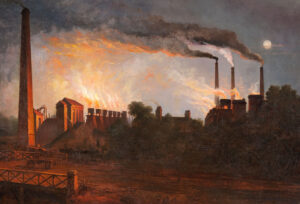From Coal to Climate Change
This case study is about working with schools and visitors to make links between the climate crisis and the industrial history of a community.
This project was funded by our COP Conversations Fund.

Introduction
In this case study David McDonald, Learning and Access Officer, talks about working with schools and visitors to make links between the climate crisis and the history of their community.
The project
Summerlee Museum is a museum of industrial and social history which tells the story of Coatbridge and its iron industry during the Industrial Revolution.
During From Coal to Climate Change we created a school workshop and accompanying guided tour of the museum and site which aims to enable visitors to make links between the climate crisis and the history of their community.
Funding from the Museums Galleries Scotland COP Conversations Fund (2021) was used to resource a new school workshop. In this two-part workshop pupils learn about the iron and coal industries in Coatbridge and how they have contributed to climate change through carbon emissions. They also learn about how we can reduce our emissions through non-polluting energy sources.
The header image on this page shows the Gartsherrie Ironworks in Coatbridge. Gartsherrie ran 16 blast furnaces, making it one of the largest ironworks in Europe at the time.
The painting is by C.R. Stanley, an English landscape painter who painted the ironworks whilst on a painting tour of Scotland in 1853. The painting was used in this project to make explicit the link between climate change, a contemporary issue, and Scotland’s industrial heritage. The painting clearly shows pollution from the ironworks and so helps visitors make the link between Victorian industry and the greenhouse effect.
Challenges & successes
- A major success of the project was resourcing a new STEM workshop for the museum.
- We successfully generated visits for the workshops from our target audience of upper primary school children.
- We had difficulties in reaching our audience for the guided tours as it was aimed at an older audience of high school pupils and adults. We have well established and effective communications with the primary school and family audience, but were less successful in reaching the more adult audience that the tours were aimed at.
- There were worries that we had to overcome that this subject was too political for a local authority museum.
The impact it has made
- The project showed how heritage can help us understand current events and inform or inspire activism.
- The Museums Galleries Scotland funding we secured for the project provided free educational experiences in a SIMD target area.
- The project has created a permanent workshop that will generate visits and income for the museum in the future.
- The schools workshop attracted more bookings than we anticipated, and continues to be booked today.
Lessons learned
- Despite some initial worries that the climate crisis was too political a subject for a local authority museum we highlighted through this project that museums can be political and be part of current conversations about social issues, as they aren’t just spaces for learning about history.
- People are looking for help in understanding and navigating debates.
- Don’t buy all the kit at once – make sure it works first!! We bought four fans to blow on the windmills but they weren’t powerful enough and were wasted. We should have bought one to test!
- We wouldn’t run a pre booking system for the guided tours in the future, as when the tours were full people could no longer book and they may have not come to the museum as a result. Since people who booked didn’t always show up it would be better to advertise this on a first come first served basis.
Guidance
- Museums are experts, not necessarily in climate change, but in something related to it. Use your expertise to inform the debate – even if you only cover some of it.